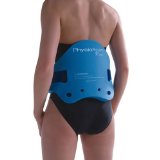Aqua-jogging (sometimes referred to as aqua-running) is basically running in deeper water in a swimming pool. The athlete is supported by an aqua-jogging belt which provides buoyancy support to maintain an upright position in the water.
With the aqua-jogging belt on and in the pool (where the feet do not touch the bottom) start the running action. The technique should be no different to the normal style of running on dry land i.e. tall posture with high hips, relaxed shoulders with efficient backward arm driving. For the most effective workout hands should be flat, pointing forward to cut through the water and not used as paddles. The most noticeable difference to be experienced will be the speed of movement i.e. moving through the water will be very slow due to the water resistance.
Aqua-jogging can be used as an extremely effective “recovery run” because of the low to zero impact on the muscles and joints. This helps to avoid muscle soreness, aching joints and potential stress fractures. In many cases athletes are able to use this form of exercise when recovering from injury and needing to maintain a level of fitness. It is of course necessary to check the level of activity that can be practised with a qualified medical or sports injury specialist before exercising after injury.
From a runner’s perspective aqua-jogging can easily be built into a training schedule. It may be beneficial when training for longer distance events e.g. marathon where the schedule can easily span 16 to 20+ weeks. In this circumstance some sessions “in the water” that can be considered supplementary to a standard running training schedule and can include:
Long Run
In the event running outside is not possible then aqua-jogging for an equivalent duration will be an effective workout. This will stress the cardiovascular system and will use the same running specific muscles.
Recovery
Many runners plan a recovery run the day following their “long” run. This can also be effectively achieved aqua-jogging with a steady easy paced session, time rather than distance is probably the better measure for this session. A 40 minute steady paced session will provide a suitable “recovery run”.
Drills
Running drills can be practised very effectively whilst aqua-jogging. Applying the same principles as if on dry land i.e. high hips, tall posture and relaxed shoulders; drills can be used to either refine running technique or to help improve fitness. Before starting any drills ensure a suitable warm up; this can be as simple as easy jogging then increasing the pace to increase the heart rate and body temperature. High knee and heel to butt drills work very well in the pool.
High knees: The purpose of this drill is to improve cadence and knee lift when an increase in pace is required. Start jogging and when comfortably moving forward, lift the leg in front of you such that the knee is parallel to the surface, toe pointing upwards and driving the opposite arm backwards. Maintain a tall and upright posture and ensure the foot is in a dorsiflexion position.
Heel to butt: The aim of this drill is also to increase cadence and improve knee lift for when you need to pick up the pace. Similar to high knees but with the emphasis on the hamstrings and the recovery stage of your stride.
Start jogging; increase the stride rate, aiming to get the legs moving in a cyclic motion with the lower leg swinging up behind you. The heel should hit the lower part of the butt. Arms should be strongly driving backwards.
Reps/Intervals
Time related or distance related repetitions can be practised easily in the pool. Examples of standard reps can include: 3 min. effort with 1min 30sec static recovery or 50m with a recovery time equivalent to 50% of the effort time. Time or distance can be varied depending upon the training required. Variations can include: pyramid sessions, high intensity maximal speed sessions etc. To make this into a new interval session rather than including a static recovery use an active roll-on recovery.
